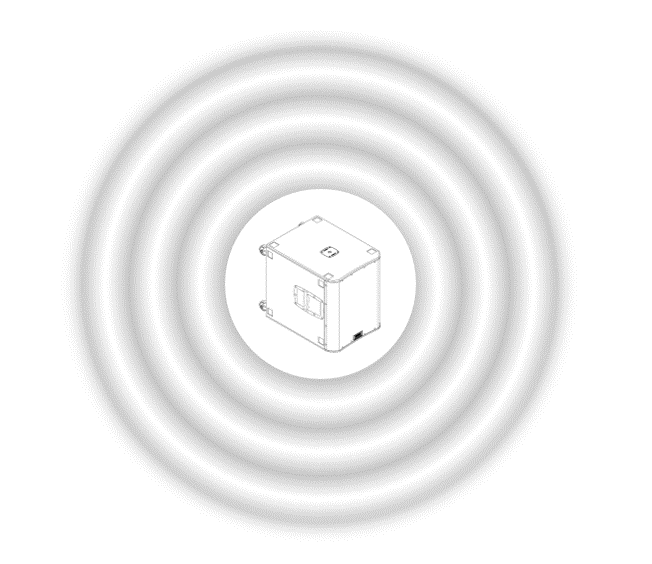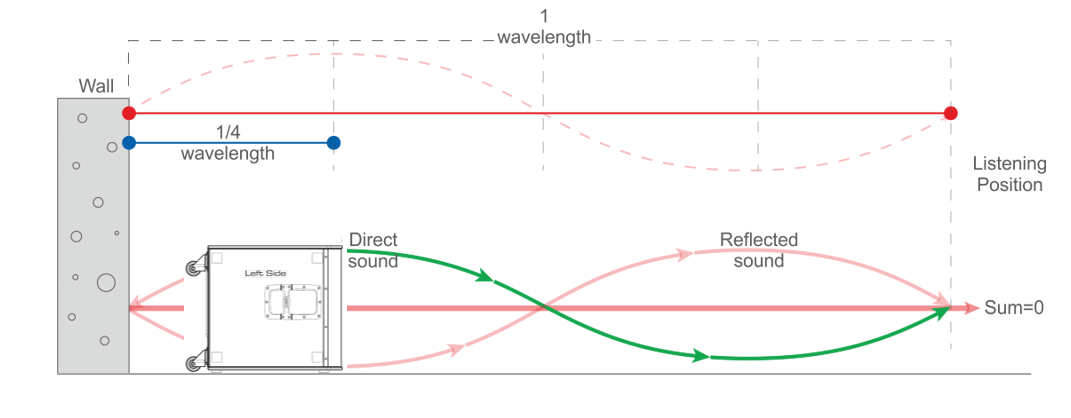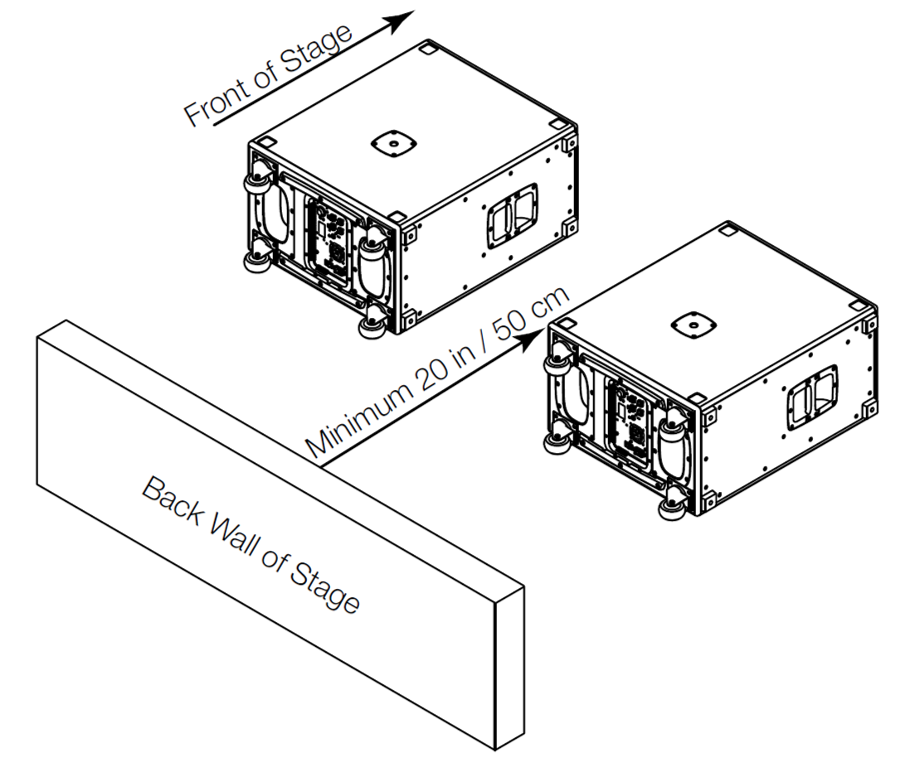Have you ever wondered if subwoofers can be placed anywhere in a room, on a stage or below it? Have you ever experienced listening to a subwoofer that had no punch, impact and definition? In fact, the placement of a subwoofer in a room or a club, on stage or simply on the floor is a critical aspect of managing low frequencies. Let’s try to understand why, first. Then, we will look at how to find the best location for a subwoofer relative to nearby walls.
Subwoofer Sound Radiation
Let’s first remember that sound propagates differently depending on frequencies. As subwoofers only generate low frequencies, typically well below 200 Hz, all types of subwoofer design – apart from cardioid solutions – produce an omnidirectional sound radiation. This implies that sound energy propagates in all directions, towards the audience but also towards any hard, solid structure located behind the subwoofer. This is where we have to turn our attention.

Back Wall Cancellation
When there is some distance between a subwoofer and a hard, solid wall behind it, at the frequency where this distance is equal to one quarter of the sound wavelength emitted, the wall reflection is out of phase with the subwoofer forward radiation. Hence, the sound reflected by the wall at this specific frequency will cancel the subwoofer’s forward radiation of the same frequency.
Let’s recall here the definition of the speed of sound. The speed of sound ‘C’ (at sea level, at 21 degrees Celsius (70 degrees Fahrenheit) and under normal atmospheric conditions) is 344 m/s (1128 ft/s) and is defined as:
C = f λ where ‘f’ represents frequency and ‘λ’ wavelength.
This equation lets us easily find the quarter wavelength for any given frequency. As an example, the lowest note on a standard guitar (open low E string) is about 83 Hz. The quarter wavelength is 1.0 m (3.3 ft).
Hence, we can conclude that if a subwoofer is placed 1.0 m away from a hard, solid wall behind it, its forward-radiating frequency response will display a significant notch in at 83 Hz. This is called ‘low frequency comb filtering cancellation’ and, unfortunately, equalization of the subwoofer’s output does not help, as the same level change applies also to the reflected sound off the wall. This is why the location of the subwoofer relative to the back wall has a significant impact on the overall low frequency reproduction quality and musicality.

Subwoofers’ Placement Guidelines
Now, let’s look at QSC KS Series active subwoofers’ specifications and draw some numerical conclusions. In all KS Series subwoofers, the ultra-compact, single 12-inch KS112 has the widest frequency response (-6 dB) that spans from 41 to 108 Hz. For calculation simplicity, we will consider 40 and 110 Hz, which represent both ends of our subwoofer’s low frequency bandwidth.
- ¼ wavelength at 40 Hz = 2.15 m (7.0 ft)
- ¼ wavelength at 110 Hz = 0.78 m (2.56 ft)
Based on the actual subwoofer’s low frequency performance, these two calculated distances provide the guidelines we are looking for. How to use our findings?
In order to avoid these strong low frequency cancellations, we could first choose to place the subwoofer as close as possible to the back wall. This will ensure that the low frequency output is not compromised, because there is no distance behind the subwoofer. In that case, however, make sure you recall what was explained in another blog about bass boost when a loudspeaker is placed close to a wall. Adequate adjustment of its low frequency response is necessary to keep your entire PA system in balance.
However, most often, we need to place our subwoofers away from the back wall, on stage or beside it. In that case, using our numerical findings above our subwoofers can be placed either;
- Between 0 m (against the back wall) and 0.78 m from the back wall (0-2.56 ft)
- Further away than 2.15 m (7.0 ft) from the back wall
In doing so, you will ensure that the subwoofer’s low frequency reproduction remains unaltered over the entire band pass. If this same subwoofer is placed anywhere between the 0.78 m and 2.15 m range, the subwoofer’s output will lack definition, punch and tight dynamics with, possibly, some bass notes missing entirely.
Cardioid Subwoofers’ Placement
As in every rule, there are exceptions. Cardioid subwoofers, such as the QSC KS212C or KS118 (using min. two units) do not radiate sound omni-directionally. Their on-board DSP technology performs the complex processing that makes mirrored woofers interact at the rear of the enclosure(s) to produce a desirable cancellation, while simultaneously interacting at the front of the enclosure(s) to produce equally desirable summation. As a result, their radiation patterns display an ideal cardioid (heart) shape, with 15 dB higher level at the front than at the rear. The sound radiation towards the back hard, solid wall is almost inexistent.
This said, there still is the need for a minimum distance between the cardioid subwoofer and the back wall. Valid for both KS212C and KS118 (using min. two units), make sure that no cardioid subwoofers are placed closer than 0.5 m (20 inches) form the back wall.

Conclusion
Today, subwoofers are used in many portable and installed PA applications. To enhance the overall listening and performance experience, their placement in a room, on stage or below it is, in fact, critical. Understanding how to easily calculate the distances from a hard, solid back wall to where subwoofers can be safely placed in order to provide a great bass listening experience is important. Now that you know about it, do not forget, whenever needed, to do some simple math in order to enjoy a great bass experience.
Christophe Anet
Latest posts by Christophe Anet (see all)
- History, Development and Applications of Column Loudspeakers - May 30, 2025
- Why is Dynamic Range so important? - May 30, 2023
- Differences between Flown and Floor-Mounted Subwoofer Deployments - May 2, 2023
